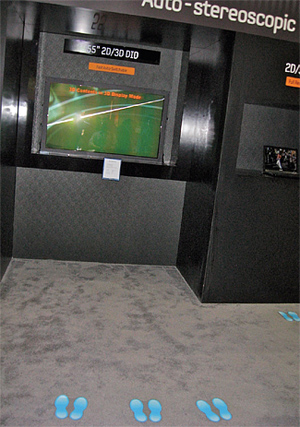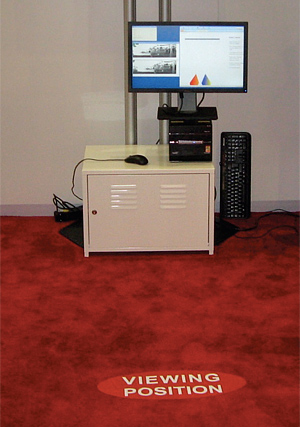When Can We Ditch the 3D Glasses?
LOS ANGELES—Almost everyone interested in seeing 3D on a home TV would be much happier if they didn't have to wear those awkward glasses to do it. For many, seeing glasses-free, or "autostereoscopic" AS3D images on a small screen like the Nintendo 3DS or several models of cell phones encourages the conclusion that it's simply a matter of upscaling the technology to get the same effect in the home.
According to Jim Chabin, president of the International 3D Society, that misguided hope is hindering the adoption of home 3DTV.
"Consumers may be waiting to buy a home 3DTV until they can be viewed without glasses," Chabin said. "I think the idea that we are going to be moving any time soon to a practical, home autostereoscopic screen is still a couple of technological breakthroughs away."
LENTICULAR VS. PARALLAX
This was clearly illustrated at May's SID Display Week 2011 conference held at the Los Angeles Convention Center. There are currently two technologies being used for most AS3D displays: a lenticular screen through which tiny lenses on the display's front separate the left and right images for the viewer; and a parallax barrier which is a filtering mask on the screen that divert the left/right images toward the viewer's eyes.
Both Toshiba and Fraunhofer had AS3D displays large enough for home theater on the Display Week's exhibit floor. Toshiba's 21-inch set (Fig. 1) used a lenticular lens sheet on its screen to create the AS3D illusion; the 42-inch Fraunhofer model (Fig. 2) also utilized a lenticular lens overlay but in addition incorporated their head tracking technology.
Notice the designated viewing areas on the floor in front of them. They are there to indicate where the observer has to stand to properly get the 3D effect.

Fig. 1: Toshiba’s 21-inch set used a lenticular lens sheet on its screen to create the AS3D illusion

Fig. 2: The 42-inch Fraunhofer model also utilized a lenticular lens overlay but in addition incorporated their head tracking technology.
But why isn't home AS3D just a matter of producing a larger version of the handheld autostereoscopic devices? David Hoffman, who recently earned his doctorate at UC Berkley's School of Optometry where he specialized in the effects of 3D on viewers, is an imaging engineer at MediaTek. According to Hoffman, it all has to do with the fact that most people's eyes are roughly 6 cm apart (the interocular distance) and you need to present each eye with a discrete image so the brain can merge them into the perception of stereopsis.
"To get an autostereoscopic display to work, you need to send two different images at slightly different directions from the screen to the eyes," Dr. Hoffman said. "If a cell phone is being held in your hand, say only 30 cm away, the angle from the display screen that the two images need to diverge is fairly large. But if a viewer is 6 feet away from a home display, the angle that is needed to separate those two images is relatively very small. That is why it is not very easy to get the correct image to the appropriate eye when watching a home autostereoscopic display."
STILL MANY YEARS AWAY
So what will it take to produce a true glasses-free home display that would be as comfortable for multiple people to watch over the duration of a whole movie or sporting event as today's glasses-dependent models?
"In terms of a marketable product, it is clearly many years away," said Phil Lelyveld, program manager, Consumer 3D Experience Lab in the Entertainment Technology Center at USC. "3D is the one of the first art forms that impacts your visual system and can have a health response on it. Some autostereoscopic display technologies can be very age-dependent, and market research has found that people in their early 20's and younger can more readily accept the AS3D effect, but people in their 20's and older find it very annoying."
There is a new autostereoscopic 3D technology that has been announced from MIT's Media Lab called HR3D (High-Rank 3D) that may someday provide another alternative for dumping 3D glasses. HR3D utilizes a pair of layered LCD panels with the top screen displaying a variable pattern based on the image below it, letting each eye see a slightly different image.
MIT claims its HR3D technology gets around the compromise on screen brightness caused by either lenticular or parallax barrier overlays and provides a wider viewing angle. Media Lab engineers recently announced an HR3D prototype created from two Viewsonic VX2265wm displays that was made by removing the LCDs from their housings and pulling off their polarizing filters and films. That way the top LCD can display a pattern of left/right views customized to the image beneath it.
But even MIT's own press release on its HR3D development said a viewer would have to "stand the right distance away" for the 3D image to pop out.
With new, passive 3DTVs enabling the use of cheaper and lighter glasses, it seems we will have to tolerate those unwanted 3D specs for some time if we want to enjoy stereoscopic home 3DTV. After all, with stereo audio being commercially available for over half a century, nobody has figured out a way to get true stereo sound out of a just single speaker.
Get the TV Tech Newsletter
The professional video industry's #1 source for news, trends and product and tech information. Sign up below.
